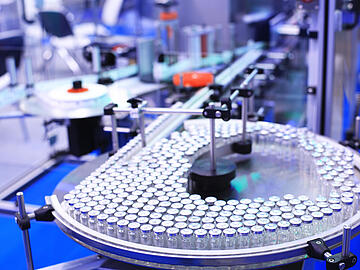
Vaccine Quality Control: Total Protein Determination by TN Analysis
Wed 18 Nov, 2020
Vaccine quality: Determine total protein content using TN analysis
TN stands for the total nitrogen. The sum parameter is easy to measure and allows safe and reliable conclusions about the total protein content in a pharmaceutical aqueous solution. The total protein content is an important quality parameter in pharmaceutical vaccine production. This article explains how you can determine the total protein content quickly and easily using TN analysis.
Vaccines must be regularly tested for their antibody content during production. Typically, this is done by measuring the concentration of attenuated or devitalized viruses or bacteria. Since these antibodies consist of proteins, analytical quantification via the total protein content has become established as the standard parameter. For this determination, the pharmacopoeias list several suitable methods, including various UV/Vis methods and two methods for measuring total nitrogen. One of them is the catalytic combustion method, which is the subject of this article. In the production of vaccines for allergy treatment, this TN test method can also be used to analyze raw materials such as pollen lyophilisates, intermediates or different dosage forms such as desensitization vaccines, prick test solutions or sublingual drugs.
Catalytic combustion method for TN determination
The European Pharmacopoeia (Pharm. Eur. Monograph 2.5.33, Method 7 B) describes the catalytic combustion method as high-temperature pyrolysis of nitrogen compounds to nitrogen monoxide (NO) in an oxygen-rich atmosphere, followed by quantification by a chemiluminescence detector (CLD). Since the nitrogen content of proteins varies only very slightly, the total nitrogen content can be converted into total protein content by application of a well-characterized and readily available protein reference material, e.g. BSA (bovine serum albumin). The protein content results from the total nitrogen multiplied by the factor 6.25: C [Total Protein] = c [Total Nitrogen] x 6.25.
The method described in the European Pharmacopoeia is almost identical to the European Standard DIN EN 12260, which also describes a catalytic combustion method with subsequent chemiluminescence detection of the resulting nitrogen monoxide molecules for the determination of TNb (total bound nitrogen), but for the analysis of water samples from the environment. In this respect, TNb analyzers such as the multi N/C series devices from Analytik Jena, which are widely used in the environmental sector, can also be effectively used for quality control in pharmaceutical vaccine production. However, the systems require some adaptations to meet the high data integrity and security requirements of the pharmaceutical industry.
For this purpose, Analytik Jena has launched a special multi N/C pharma series, which fully complies with the norms and standards in the pharmaceutical industry.
Total protein determination with the multi N/C 2100S pharma
The multi N/C 2100S pharma offers pharmaceutical laboratories several advantages for routine total protein determination by TN analysis. For example, the TN analyzer features an innovative system for direct injection of samples using a microliter syringe and a septum-free, pneumatic injection head. Since no additional valves or tubes are required, this injection method allows short and direct sample transfer from the sample vessel to the combustion chamber, thus preventing sample carry-over. Cleaning and rinsing of the sample supply also becomes more effective and saves sample resources, as only a few rinsing cycles are required for the very short sample dosing line. For five measurements with three rinse cycles and a representative injection volume of 75 µl, only 1.5 ml sample material is required. Thus, a 112 position autosampler tray with 2 ml HPLC vials can be used. On the other hand, reliable results are guaranteed thanks to the high temperature oxidation and the sensitive CLD detector. An example measurement will briefly illustrate this.
Example: TN in vaccine samples and urea control standards against a BSA calibration
For this example measurement, five urea TN standards, one BSA control standard and three vaccine samples from three independent fillings each were measured. After conditioning at room temperature, the samples were pipetted with a micropipette directly into 2 ml sample vials and sealed with septum caps. Sample aliquots from 75 μl were then injected into the combustion furnace of the multi N/C 2100S pharma using the microliter syringe of the autosampler. The autosampler used was the AS 60 from Analytik Jena, which has an automatic magnetic stirring function and a rinsing station for the injection syringe. The stirring function supports sample homogenization, especially in the case of samples containing particles, and thus enables the reproducible measurement of representative sample aliquots. The intensive cleaning of the dosing syringe via the rinsing station prevents the carry-over ofsample residues into the next measurement, especially with protein-containing solutions.
In a pure oxygen atmosphere, all nitrogen compounds were then converted into nitrogen monoxide (NO) by means of catalytic high-temperature combustion at 800 °C. The multi N/C 2100S pharma uses a platinum catalyst for complete sample oxidation. The NO was then quantitatively detected using a CLD detector.
The analyzer was calibrated with a multi-point calibration from 5 to 60 mg/l for TN using a BSA protein standard solution (reference protein: bovine serum albumin). The standard conversion factor of 6.25 was applied to calculate the protein concentration from the measured nitrogen concentration.
The measurement of the standards and the samples show a very good repeatability and a very low standard deviation RSD with short measuring times of 3 - 4 minutes per injection. The measurement curves show neither deviations between replicate measurements nor significant peak tailing effects.
For detailed information on the method, please refer to our corresponding Application Note.
Related Downloads
eBook: TOC in Pharma Simplify pharmaceutical TOC/TN applications with the multi N/C pharma series
Form cleaning validation to total protein determination - this eBook provides methods to simplify sme major TOC/TN applications in the pharmaceutical industry.
Leave a comment
Write new comment
Contact us
The newsletter of Analytik Jena frequently keeps you posted about:
- News
- Trends and developments
- Events

Comments (0)
No comments found!